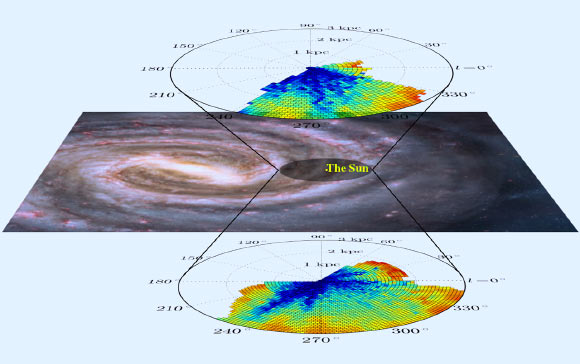A group of astronomers from Europe, Australia and the United States led by Dr Janez Kos of the University of Ljubljana in Slovenia has produced pseudo-3D maps of the material located between the stars in our Milky Way Galaxy.

Maps of the measured DIB absorption in respect to the area they cover in our Milky Way Galaxy. Image credit: Janez Kos / Nick Risinger / RAVE team.
Analyzing bands of starlight that have passed through space gives scientists information about the makeup of the space materials that the light has encountered.
In 1922, U.S. astronomer Mary Lea Heger discovered dark lines indicating ‘missing’ starlight, which must have been absorbed by a yet unknown source. These mysterious features were called diffuse interstellar bands, or DIBs.
Since then, scientists have identified more than 400 DIBs, but the material that is causing these bands to appear and their precise location have remained a mystery.
In a new approach to understanding DIBs, Dr Kos and his co-authors combined information from nearly 500,000 stellar spectra obtained by the RAVE (Radial Velocity Experiment) survey to produce pseudo-3D maps of the DIB-material at 862 nm covering the nearest 9,800 light-years from our Solar System.
RAVE project used the UK Schmidt Telescope in Australia to collect spectroscopic information from the light of as many as 150 stars at once.
The resulting maps are described as ‘pseudo-3D’ because a specific mathematical form was assumed for the distribution in the vertical dimension that provides the distances from the plane of the Milky Way, with the maps presented in the remaining two dimensions.
The maps showed the intriguing result that the complex molecules thought to be responsible for the DIBs are distributed differently than another known component of the interstellar medium – the solid particles known as dust – also traced by the RAVE survey.
“With the wide area coverage of the spectroscopic survey RAVE it was for the first time possible to map out the 3D distribution of the DIBs,” said Dr Matthias Steinmetz of the Leibniz Institute for Astrophysics Potsdam, who is a co-author of the paper reporting the results in the journal Science.
“We could show that the complex molecules responsible for the DIB features can also be found at larger distances to the Galactic plane than it is the case for interstellar dust.”
Future studies can use the new approach to assemble other maps that should further solve the mysteries surrounding where DIBs are located and what materials cause them.
_____
Janez Kos et al. 2014. Pseudo–three-dimensional maps of the diffuse interstellar band at 862 nm. Science, vol. 345, no. 6198, pp. 791-795; doi: 10.1126/science.1253171







